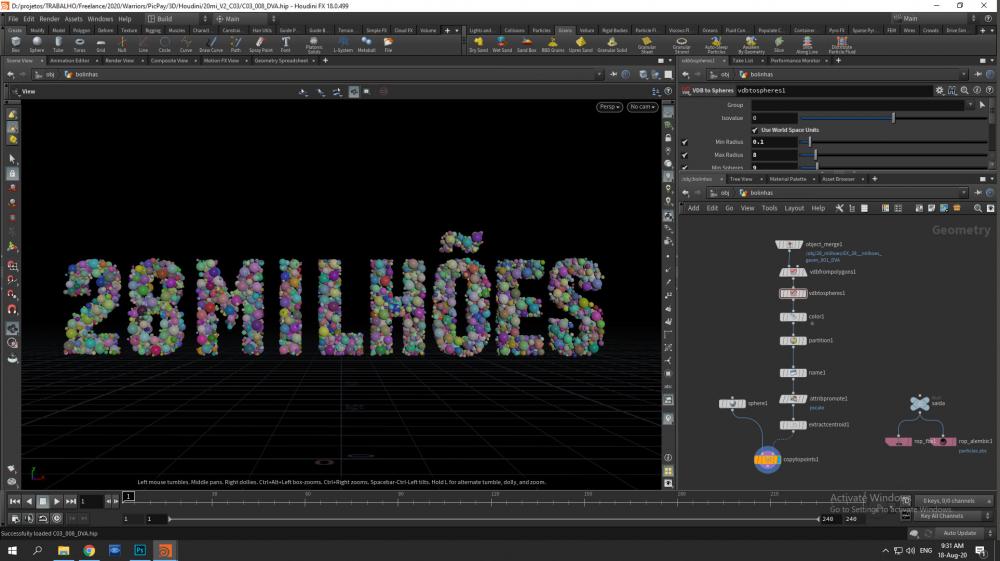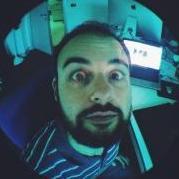Search the Community
Showing results for tags 'goal'.
-
Hello! I am still very much getting acquainted with Houdini, but every time I need to use it I have a very specific purpose. This one has me stumped for now, but I am sure that someone versed in Houdini dynamics will resolve it very quickly! What I want to do is: fill a volume with spheres, make said spheres bounce off of each other on contact (like snooker balls), but also try and accommodate themselves onto the original shape (created by the volume). I have tried this with grains, but didn´t get too far. I am betting on doing it with particles: This path seems a lot more promising! I can get the ball´s pscale and id attributes, which will be a boon later on, when I need to swap the balls for different emojis (yes, it´s for a TV ad!). What I need to do: duplicate the current particle so I can use it as a "goal shape", with the same ids. This I can do. add an initial offset to the particles from the surface, ideally from the normals of the original geometry (or a smoothed copy). I can somewhat get it by tweaking the iso offset of the vdbtospheres node, but I worry that the IDs will be messed up. Ideally, I would add an offset to them, but not add any velocity. add a small amount of turbulence to the particles. This will eventually be animated to 0. make them collide with each other, based on their sphere geometry. The eventual geometry is basically spheres as well. make them try and reach their goal, and eventually settle down (a slider for this would be great!) Seems very achievable, but I need some light on how to make these connections! After that, I still will need to swap the spheres for 4 different groups of geometries, but I believe that I can glean information from tokeru.com (Emit_packed_prims_into_RBD_sim), and make it happen. Any help with this will be GREATLY appreciated! This is the scene file: C03_008_DVA.hip (if anyone is interested in taking a look at it!) cheers, Diego
- 2 replies
-
- rbd
- turbulence
- (and 5 more)
-
hey all! I'm starting to think on how to replicate an effect like this one attached. I'm starting to think about particles attracted by an object, and when particles are close enough or hit the object they inject opacity into the mesh and reveal the object itself. In houdini I'm starting with a simple POP attractor, but I'm having some back and forth elastic effect with particles (I supposed that is due to the pop force node that is keeping particles moving...). So what I'm trying to do is something that is snapping particles to their goal once they are close enough, and also how can I tell to the particles to get the color of their goal from the beginning, and how to kill them when they are close to the goal, and also how can I transfer the hit information to the mesh so I can make it appear...so many questions! thanks to anyone who can drop an idea! attractor_v001.hiplc SAMSUNG Pixel_1.mp4 SAMSUNG Pixel_2.mp4
-
Genius Houdini Community! I'm having a hard time wrapping my head around something so I thought it best to ask the experts out there. We're about to do a project where a rigid object ( like a box or a tea kettle ) is floating weightlessly in a room. It is being blown around by wind and bumping into objects as it goes. What we would like to do is loosely keyframe the object for basic choreography and timing but have the dynamic object "follow" it, like a target. This way you get the benefit of having keyframed motion influencing the dynamics. Would a sop solver be the right way to go here? Field force? It's been a while since I used dops so any advice or examples would be appreciated. I'm sure there's an elegant solution out there but I'm just not able to think of it. Thanks very much!
-
Hello everybody, I've been studying Houdini for quite a while now but still I find situations where I get terribly stuck. I need to produce a controlled simulation of a simple pearl bracelet which, after falling and landing on the ground, gets a precise 2d shape (a number for instance). I thought about creating a wire simulation and then copy spheres of the points after the sim, or make a rbd constraint of every pearl (which I realized I am not able). Yet, I don't understand how to drive the second part of the simulation, the one in which the bracelet moves to adapt to the 2d shape. I've worked with POP Attract or using a single point to advect RBD objects through a constant force but I feel these are far away from the solution. Could anyone help? An example scene would be much appreciated. Thanks a lot.



